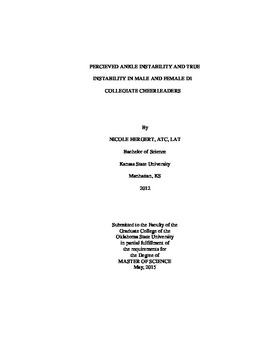| dc.contributor.advisor | O'Brien, Matthew | |
| dc.contributor.author | Hergert, Nicole | |
| dc.date.accessioned | 2016-04-15T21:49:24Z | |
| dc.date.available | 2016-04-15T21:49:24Z | |
| dc.date.issued | 2015-05-01 | |
| dc.identifier.uri | https://hdl.handle.net/11244/33421 | |
| dc.description.abstract | Context: Ankle sprains are a common injury for athletes and other activities such as cheerleading. Previous authors have presented evidence that certain shoes can significantly impair the individuals�� sense of proprioception while wearing shoes that can potentially lead to ankle sprains. Objective: The purpose of this study was to compare perceived stability and the overall stability of cheerleaders�� ankles barefoot and while wearing cheer shoes. Design: Randomized Cross Over DesignSetting: Clinical SettingPatients/Participants: 30 Division 1A Cheerleaders, 14 males, and 16 females with no history of head trauma or ankle injuries within the past month. Interventions: Participants were randomly assigned to start barefoot or with shoes on for a one time test on the Balance Biodex System. Main Outcome Measure(s): Each participants perceived ankle stability was determined using the Cumberland Ankle Instability Tool (CAIT), while overall ankle stability was assessed with shoes on and shoes off while standing in a series of conditions including dominant single leg stance, non dominant stance and both legs on the Biodex Balance System. Results: A significant difference was found (p��.05) with shoes on versus without shoes in all stances. The relationship between the participant��s perceived ankle stability and actual overall stability scores lacked a significant correlation. Males were also found to have better overall stability with shoes on and off while standing single leg dominant. Conclusion: Cheer shoes actually provided more stability rather than instability especially for males. The Cumberland Ankle Instability Tool was not a applicable measurement for this study as the results do not support its use with this population. The findings from this study show that ankle instability in cheerleaders needs further investigation into the potential cause of ankle instability. Key Words: ankle injuries, cheerleading, shoes, instability | |
| dc.format | application/pdf | |
| dc.language | en_US | |
| dc.publisher | Oklahoma State University | |
| dc.rights | Copyright is held by the author who has granted the Oklahoma State University Library the non-exclusive right to share this material in its institutional repository. Contact Digital Library Services at lib-dls@okstate.edu or 405-744-9161 for the permission policy on the use, reproduction or distribution of this material. | |
| dc.title | Perceived Ankle Instabiliy and True Instability in Male and Female D1 Collegiate Cheerleaders | |
| dc.type | text | |
| dc.contributor.committeeMember | Volberding, Jennifer | |
| dc.contributor.committeeMember | Warren, Aric | |
| osu.filename | Hergert_okstate_0664M_13873.pdf | |
| osu.accesstype | Open Access | |
| dc.description.department | Education (PhD) | |
| dc.type.genre | Thesis | |
